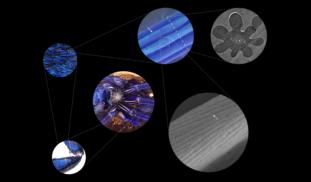Photonic Professional GT trial

The picture above shows our first attempt to print out synthetic tarantula hairs using Photonic Professional GT as a proof-of-concept, to evaluate the feasibility of our experimental design. The tiny white dot in the middle of the transparent glass swatch is the printed structure.

Panel A shows the transverse (axial) cross section (TEM micrograph) of a real blue hair from an adult female Singapore blue tarantula. The diameter of the hair is ~1/20 that of a human hair. Scale bar is 2 μm. Panel B is our designed structure modeled after panel A. The diameter of this structure is 15 μm, due to instrumental constraints of Photonic Professional GT. Panel C is the prototype printed by Photonic Professional GT. The prototype structure matches our design well!

Panel D is a SEM micrograph of a blue hair from Singapore blue tarantula. Scale bar is also 2 μm. Panel E is the designed prototype. Panel F is the printed structure. Again, we see that the printed structure shows great agreement with both the designed prototype and the morphology of a real blue tarantula hair.

This prototype is so small, that it can rest atop a human hair.

Panel G is the image of a single blue tarantula hair under a light microscope. Panel H is the image of printed prototype structures under a light microscope. Blue/green structural colors were observed from the printed structures. Panel I shows the predicted and measured reflectance spectra of the prototype. The blue dashed curve is the predicted spectrum based on optical simulation of the design. The red curve is the experimental spectrum measured from the printed prototype. The peaks of both curves match up closely.







2 comments